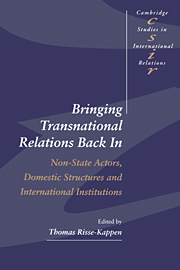 Bringing Transnational Relations Back In
Bringing Transnational Relations Back In Book contents
- Frontmatter
- Contents
- List of tables
- List of contributors
- Preface
- List of abbreviations
- Setting the agenda
- Case studies
- 2 Transnational relations and the development of European economic and monetary union
- 3 “Bullying,” “buying,” and “binding”: US–Japanese transnational relations and domestic structures
- 4 MNCs and developmentalism: domestic structure as an explanation for East Asian dynamism
- 5 Transnational relations, domestic structures, and security policy in the USSR and Russia
- 6 Mechanics of change: social movements, transnational coalitions, and the transformation processes in Eastern Europe
- 7 Ivory, conservation, and environmental transnational coalitions
- Conclusions: So what?
- Index
- CAMBRIDGE STUDIES IN INTERNATIONAL RELATIONS
3 - “Bullying,” “buying,” and “binding”: US–Japanese transnational relations and domestic structures
Published online by Cambridge University Press: 02 December 2009
- Frontmatter
- Contents
- List of tables
- List of contributors
- Preface
- List of abbreviations
- Setting the agenda
- Case studies
- 2 Transnational relations and the development of European economic and monetary union
- 3 “Bullying,” “buying,” and “binding”: US–Japanese transnational relations and domestic structures
- 4 MNCs and developmentalism: domestic structure as an explanation for East Asian dynamism
- 5 Transnational relations, domestic structures, and security policy in the USSR and Russia
- 6 Mechanics of change: social movements, transnational coalitions, and the transformation processes in Eastern Europe
- 7 Ivory, conservation, and environmental transnational coalitions
- Conclusions: So what?
- Index
- CAMBRIDGE STUDIES IN INTERNATIONAL RELATIONS
Summary
The problem addressed by this chapter is illustrated by the difference in the political strategy and tactics adopted by the American automobile and the Japanese electronics industries. Confronted by growing American protectionism in the 1970s and 1980s, Japanese corporations increasingly invested in American plants and produced in North America. But in some situations Japanese corporations also acted politically. When it became clear in 1987 that one of the Toshiba Group Corporations had sold to the Soviet Union sensitive technologies, it confronted a possible economic boycott in Congress. The Toshiba Group waged a sophisticated public relations campaign that succeeded brilliantly in undercutting the political forces in Congress favoring the embargo. The American automobile industry, on the other hand, in a period of deep recession, plunging sales, and mounting losses relied on its political connections with Congress and the White House to initiate negotiations over voluntary export restraints with Japan in 1981. These restraints have been periodically renewed throughout the 1980s, first in bilateral negotiations between the United States and Japan and, since 1985, unilaterally by Japan. When the automobile industry faced again economic hardship in 1991, the heads of the three major automobile corporations, blaming Japan for “unfair competition” joined the President of the United States in an ill-fated mission to Tokyo. The President returned with an empty stomach, the industry with empty hands.
There exists then a very great difference in how Americans typically pursue their political objectives in Tokyo and how the Japanese typically proceed in the United States. For reasons of convenience this is referred to here as the difference between “bullying,” “buying,” and “binding.”
- Type
- Chapter
- Information
- Bringing Transnational Relations Back InNon-State Actors, Domestic Structures and International Institutions, pp. 79 - 111Publisher: Cambridge University PressPrint publication year: 1995
- 3
- Cited by


